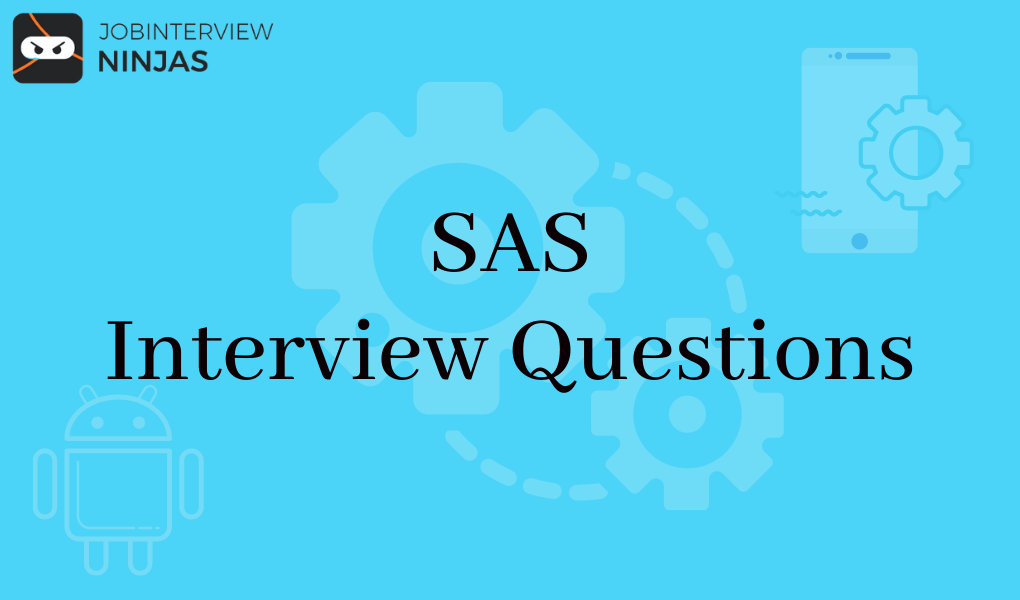
Top 40 Jenkins Interview Questions And Answers For Freshers/Experienced
If you are looking for a career in software development, then Jenkins is definitely worth exploring. This widely used …

Here we have given the list of 45 top SAS Interview Questions for freshers and experienced candidates to practice. These are the questions that are often asked in interviews related to the Statistical Analysis System topic so if you are appearing for a technical job interview then you are advised to go through all the SAS Interview Questions and answers given here.
About SAS: Statistical Analysis System (SAS) is a statistical software suite created by SAS Institute for advanced analytics, data management, business intelligence, multivariate analysis, predictive analytics, and criminal investigation. SAS was invented at North Carolina State University when SAS Institute was included.
1. Explain SAS and its functions?
2. Tell the primary structure of the SAS base program?
3. Explain SAS basic syntax style?
4. What do you understand by data step in SAS?
5. Tell me the use of the %include statement?
6. Name the data types of SAS?
7. Name the statement that does not execute automatic conversions in comparisons?
8. Name the method to debug and test your SAS program?
9. Differentiate between nodupkey and nodup?
10. Name SAS validation tools?
11. Tell me the command used to find missing values?
12. Tell the function of Proc summary?
15. SAS Informats are placed in what types of categories?
17. Tell me the use of PROC gplot?
19. Describe the SAS data set?
20. Tell me some key concepts of SAS
21. Differentiate between INPUT and INFILE?
22. Differentiate between INFORMAT and FORMAT?
24. How to read the variables that you require?
25. Name the special input delimiters used in SAS?
26. How does SAS behave towards DSD delimiters?
27. Name the good SAS programming practices for processing big data sets?
28. Tell me the way to exclude or include specific variables in a data set?
29. In SAS, how SUBSTR function works?
30. What SAS features helps in checking errors and data validation?
31. Name the ways to do a “table lookup”?
32. Which statements are used to generate test data with no input data?
33. Differentiate CEIL and FLOOR functions in SAS?
34. Differentiate between SAS procedures and functions?
35. How to eliminate duplicates using PROC SQL?
36. What are general programming errors in SAS?
37. How to limit decimal places for the variable?
38. Differentiate between the SAS PROCs and SAS DATA STEP?
39. Tell me the use of the STOP statement?
40. Explain RUN-Group processing?
41. Tell me the way to test the debugging in SAS?
42. How to make a permanent SAS data set?
43. Explain the scrubbing procedures in SAS?
44. Name the default statistics that PROC MEANS produce?
45. Differentiate between Match Merge and One to One Merge?
1. Explain SAS and its functions?
2. Tell the primary structure of the SAS base program?
The primary structure of SAS includes of
==DATA step, which retrieves & manipulates data.
==PROC step, which interprets the data.
3. Explain SAS basic syntax style?
To execute the program successfully, you need to follow these basic elements:
For example: In file ‘H: \StatHW\yourfilename.dat’;
4. What do you understand by data step in SAS?
5. Tell me the use of the %include statement?
6. Name the data types of SAS?
7. Name the statement that does not execute automatic conversions in comparisons?
8. Name the method to debug and test your SAS program?
9. Differentiate between nodupkey and nodup?
10. Name SAS validation tools?
For DataSet: Data set name/ debug Data set: Name/stmtchk
For SAS Macros variables: Options: mprint mlogic symbolgen
11. Tell me the command used to find missing values?
12. Tell the function of Proc summary?
15. SAS Informats are placed in what types of categories?
17. Tell me the use of PROC gplot?
19. Describe the SAS data set?
20. Tell me some key concepts of SAS
21. Differentiate between INPUT and INFILE?
22. Differentiate between INFORMAT and FORMAT?
24. How to read the variables that you require?
25. Name the special input delimiters used in SAS?
26. How does SAS behave towards DSD delimiters?
27. Name the good SAS programming practices for processing big data sets?
28. Tell me the way to exclude or include specific variables in a data set?
29. In SAS, how SUBSTR function works?
30. What SAS features helps in checking errors and data validation?
31. Name the ways to do a “table lookup”?
32. Which statements are used to generate test data with no input data?
33. Differentiate CEIL and FLOOR functions in SAS?
34. Differentiate between SAS procedures and functions?
35. How to eliminate duplicates using PROC SQL?
To eliminate duplicates using PROC SQL use the following steps: Proc SQL noprint; Create Table inter.merged1 as Select distinct * from inter.readin ; Quit;
36. What are general programming errors in SAS?
37. How to limit decimal places for the variable?
38. Differentiate between the SAS PROCs and SAS DATA STEP?
39. Tell me the use of the STOP statement?
40. Explain RUN-Group processing?
41. Tell me the way to test the debugging in SAS?
42. How to make a permanent SAS data set?
43. Explain the scrubbing procedures in SAS?
44. Name the default statistics that PROC MEANS produce?
45. Differentiate between Match Merge and One to One Merge?

If you are looking for a career in software development, then Jenkins is definitely worth exploring. This widely used …

In this post, we will cover a few Linux interview questions and their answers. So, let’s get started. In this …